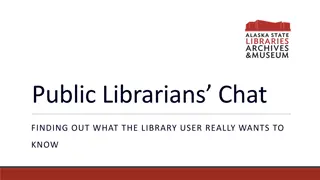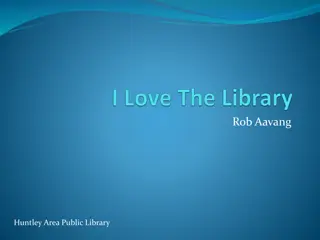Roving Reference Service and User-Centeredness in Library Spaces
Examining the impact of roving reference service models on traditional library paradigms regarding user-centeredness and space design. The study explores how modern library practices challenge established relationships, utilizing a user-centric approach to redefine spatial interactions within library environments. Data collection involves site visits, interviews, observations, and photography across academic and public libraries.
Download Presentation

Please find below an Image/Link to download the presentation.
The content on the website is provided AS IS for your information and personal use only. It may not be sold, licensed, or shared on other websites without obtaining consent from the author. Download presentation by click this link. If you encounter any issues during the download, it is possible that the publisher has removed the file from their server.
E N D
Presentation Transcript
Out of Place? Examining User-Centeredness and Roving Reference Service in Academic and Public Library Spaces City of Troy Public Library Scottsdale Public Library Matthew Griffis, Assistant Professor School of Library and Information Science, The University of Southern Mississippi matthew.griffis@usm.edu
Space, Power and the Public Library findings published in (2014) Advances in Library Administration and Organization, 32(1), 1-106. multicase (3 public libraries) found that traditional, models of space design and spatial practice prevail (even in new libraries)
Conceptual Framework social space: Lefebvre (1991), Lawson (2001) space is socially produced and determines and influences relationships between people organization space: Gutman (1972) Dale & Burrell (2008) modern organizations use space design to enforce processes and outcomes favorable to their objectives panopticism : Foucault (1973, 1977), Black, Pepper and Bagshaw (2009), Andrejewski (2008) modern institutional building types have been based on maximum efficiency ( prison ) design
Alex Wellerstein, Stevens Institute of Technology (http://alexwellerstein.com)
Roving Reference the practice of discreetly walking about the reference area of a library in search of users who need assistance, as opposed to remaining seated at the reference desk, waiting for patrons to approach with their questions - roving , Online Dictionary of LIS hybrid (desk-based and scheduled roving) vs. fully roving ( deskless ) City of Troy Public Library
Research Question To what extent, if any, do roving reference service models change the relationships that define the traditional paradigm? Library Buildings: Notes and Plans, American Library Association, 1924
Data Collection and Analysis 3 libraries (2 academic, 1 public) site visits (5-6 days per visit) semi-structured interviews with librarians and users mental mapping exercises observations of library activity photography IRB approval 02-04-15, protocol #CH15020304
Multicase Study Library A (academic library) hybrid model old building (ca. 1930s) with addition 5 operational levels Library B (academic library) hybrid model old building (ca. 1940s) with extension 3 operational levels Library C (public library) full roving model main library of 7-branch system new building (ca. 2009-10) 1 operational level Library C
Data Collection and Analysis DATA SOURCES LIBRARY A LIBRARY B LIBRARY C TOTALS 36 interviews (18 L, 18U) Interviews 8L, 3U 4L, 5U 6L, 10U Photographs 355 234 457 1046 photographs Observations 11p 9p 13p 33 pages
Findings Roving reference service models do not change the traditional, underlying power relationships within the library space. instead, these relationships are intensified roving is an alternate (and perhaps more effective) way for the librarian to be everywhere at once
Findings Despite the introduction of roving service to these libraries, the spatial practices of the traditional model still prevailed. in the hybrid libraries (A & B), users were still inclined towards using fixed service options rather than roving options at Library C, under certain conditions users and librarians reproduced spatial practices from the traditional model
Findings Roving reference as a form of information service has very limited capacity. Most substantial reference questions or queries could not be answered at the point of need and still required either directing the a stationary desk or removing them to an office.
Conclusions To what extent, if any, does the roving reference model change the traditional, desk-based spatial model? It does not. It reinforces the underlying power relationships of the traditional model. the user experience is not substantially different multiple modes of service working in partnership is ideal roving reference better as an extension of (i.e., but not a replacement for) traditional, desk-based service?
Acknowledgements This research was funded with a 2015 OCLC/ALISE Research grant. The researcher further acknowledges the interest and cooperation of the anonymous case libraries and the anonymous interview participants. References Andrejewski, A. V. (2008). Building power: Architecture and surveillance in Victorian America. Knoxville: University of Tennessee Press. Black, A., Pepper, S., and Bagshaw, K. (2009). Books, buildings and social engineering. London: Ashgate. Dale, K. & Burrell, G. (2008). The spaces of organization and the organization of space: Power, identity and materiality at work. New York: Palgrave. Foucault, M. (1973). The birth of the clinic: An archaeology of medical perception. New York: Vintage. Foucault, M. (1977). Discipline and punish: The birth of the prison. New York: Random House. Gutman, R. (1972). People and buildings. New York: Basic. Lawson, B. (2001). The language of space. Boston: Architectural Press. Lefebvre, H. (1991). The production of space. D. Nicholson-Smith, trans. Oxford: Blackwell.























